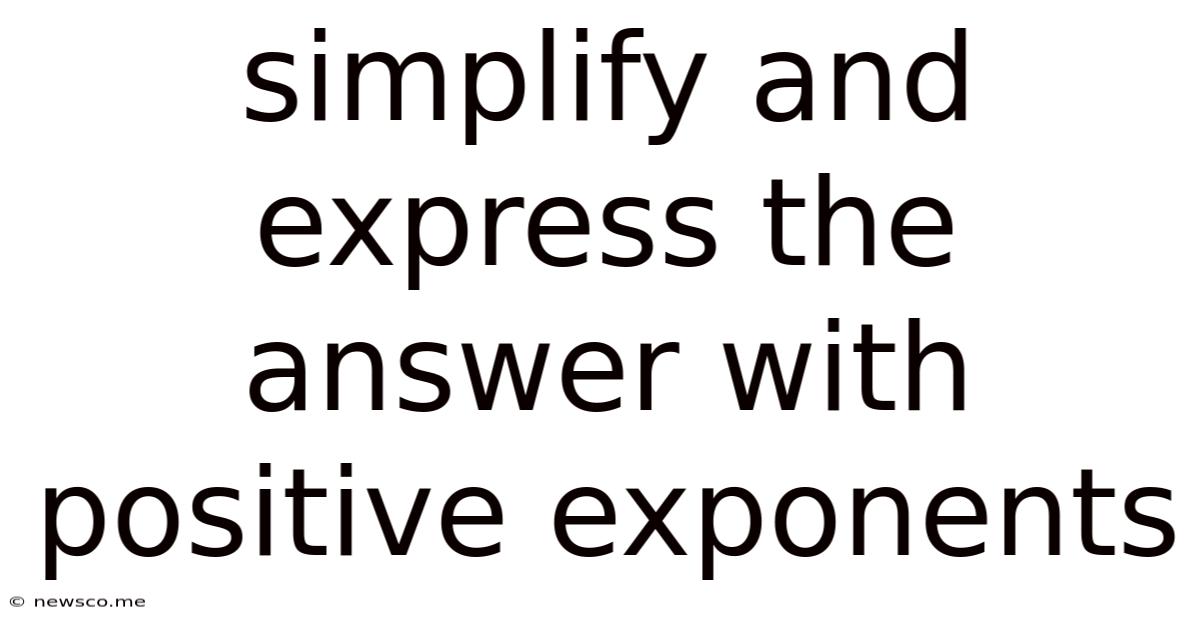Simplify And Express The Answer With Positive Exponents
News Co
May 07, 2025 · 7 min read

Table of Contents
Simplify and Express the Answer with Positive Exponents
Simplifying expressions and ensuring all exponents are positive is a fundamental skill in algebra. This process involves understanding several key concepts, including exponent rules, negative exponents, and fractional exponents. This comprehensive guide will walk you through these concepts, providing numerous examples to solidify your understanding. By the end, you'll be able to confidently simplify complex expressions and express them with only positive exponents.
Understanding Exponent Rules
Before diving into simplification, let's review the fundamental rules governing exponents:
1. Product of Powers Rule: a<sup>m</sup> * a<sup>n</sup> = a<sup>m+n</sup>
This rule states that when multiplying two terms with the same base, you add the exponents.
Example: x<sup>3</sup> * x<sup>5</sup> = x<sup>3+5</sup> = x<sup>8</sup>
2. Quotient of Powers Rule: a<sup>m</sup> / a<sup>n</sup> = a<sup>m-n</sup>
When dividing two terms with the same base, you subtract the exponents.
Example: y<sup>7</sup> / y<sup>2</sup> = y<sup>7-2</sup> = y<sup>5</sup>
3. Power of a Power Rule: (a<sup>m</sup>)<sup>n</sup> = a<sup>m*n</sup>
When raising a power to another power, you multiply the exponents.
Example: (z<sup>4</sup>)<sup>3</sup> = z<sup>4*3</sup> = z<sup>12</sup>
4. Power of a Product Rule: (ab)<sup>m</sup> = a<sup>m</sup>b<sup>m</sup>
When raising a product to a power, you raise each factor to that power.
Example: (2x)<sup>3</sup> = 2<sup>3</sup>x<sup>3</sup> = 8x<sup>3</sup>
5. Power of a Quotient Rule: (a/b)<sup>m</sup> = a<sup>m</sup>/b<sup>m</sup>
Similarly, when raising a quotient to a power, you raise both the numerator and denominator to that power.
Example: (x/y)<sup>2</sup> = x<sup>2</sup>/y<sup>2</sup>
6. Zero Exponent Rule: a<sup>0</sup> = 1 (where a ≠ 0)
Any non-zero base raised to the power of zero equals 1.
Example: 5<sup>0</sup> = 1, x<sup>0</sup> = 1 (assuming x ≠ 0)
Dealing with Negative Exponents
A negative exponent indicates a reciprocal. The rule is: a<sup>-n</sup> = 1/a<sup>n</sup> and conversely, 1/a<sup>-n</sup> = a<sup>n</sup>. This is crucial for expressing answers with only positive exponents.
Examples:
x<sup>-3</sup> = 1/x<sup>3</sup>1/y<sup>-4</sup> = y<sup>4</sup>2<sup>-2</sup> = 1/2<sup>2</sup> = 1/4(3x)<sup>-2</sup> = 1/(3x)<sup>2</sup> = 1/(9x<sup>2</sup>)
Working with Fractional Exponents
Fractional exponents represent roots and powers. The general rule is: a<sup>m/n</sup> = (<sup>n</sup>√a)<sup>m</sup> = <sup>n</sup>√(a<sup>m</sup>). This means the denominator represents the root (e.g., 2 is a square root, 3 is a cube root), and the numerator represents the power.
Examples:
x<sup>1/2</sup> = √x(square root of x)y<sup>2/3</sup> = (<sup>3</sup>√y)<sup>2</sup> = <sup>3</sup>√(y<sup>2</sup>)(the square of the cube root of y)8<sup>2/3</sup> = (<sup>3</sup>√8)<sup>2</sup> = 2<sup>2</sup> = 416<sup>3/4</sup> = (<sup>4</sup>√16)<sup>3</sup> = 2<sup>3</sup> = 8
Simplifying Expressions with Positive Exponents: Step-by-Step Approach
Let's tackle some examples, demonstrating a systematic approach to simplification:
Example 1: Simplify (2x<sup>-2</sup>y<sup>3</sup>)<sup>2</sup>(4x<sup>3</sup>y<sup>-1</sup>) and express the result with only positive exponents.
-
Apply the Power of a Product Rule: First, distribute the outer exponent (2) to each term within the parentheses:
(2<sup>2</sup>x<sup>-4</sup>y<sup>6</sup>)(4x<sup>3</sup>y<sup>-1</sup>) -
Simplify Numerical Coefficients: Multiply the numerical coefficients:
4x<sup>-4</sup>y<sup>6</sup>(4x<sup>3</sup>y<sup>-1</sup>)=16x<sup>-4</sup>y<sup>6</sup>x<sup>3</sup>y<sup>-1</sup> -
Apply the Product of Powers Rule: Combine terms with the same base by adding exponents:
16x<sup>-4+3</sup>y<sup>6+(-1)</sup>=16x<sup>-1</sup>y<sup>5</sup> -
Express with Positive Exponents: Use the rule for negative exponents to rewrite x<sup>-1</sup>:
16(1/x)y<sup>5</sup>=16y<sup>5</sup>/x
Therefore, the simplified expression is 16y<sup>5</sup>/x.
Example 2: Simplify (x<sup>2</sup>/y<sup>-3</sup>)<sup>-1</sup> and express with positive exponents.
-
Apply the Power of a Quotient Rule: Distribute the outer exponent (-1) to both numerator and denominator:
x<sup>-2</sup>/y<sup>3</sup> -
Express with Positive Exponents: Rewrite x<sup>-2</sup> with a positive exponent:
1/x<sup>2</sup> * y<sup>3</sup>
Therefore, the simplified expression is y<sup>3</sup>/x<sup>2</sup>.
Example 3: Simplify (27a<sup>6</sup>b<sup>-3</sup>)<sup>1/3</sup> and express with positive exponents.
-
Apply the Power of a Product Rule: Distribute the exponent (1/3) to each term within the parentheses:
27<sup>1/3</sup>a<sup>6*(1/3)</sup>b<sup>-3*(1/3)</sup> -
Simplify: Calculate 27<sup>1/3</sup> (which is the cube root of 27) and simplify the exponents:
3a<sup>2</sup>b<sup>-1</sup> -
Express with Positive Exponents: Rewrite b<sup>-1</sup> with a positive exponent:
3a<sup>2</sup>(1/b)=3a<sup>2</sup>/b
Therefore, the simplified expression is 3a<sup>2</sup>/b.
Example 4: Simplify (x<sup>1/2</sup>y<sup>-2</sup>)<sup>4</sup>(x<sup>-1</sup>y<sup>2</sup>) and express with positive exponents.
-
Apply the Power of a Product Rule: Distribute the exponent 4 to each term within the parentheses:
x<sup>2</sup>y<sup>-8</sup>(x<sup>-1</sup>y<sup>2</sup>) -
Apply the Product of Powers Rule: Combine the x terms and the y terms separately:
x<sup>2+(-1)</sup>y<sup>-8+2</sup>=x<sup>1</sup>y<sup>-6</sup> -
Express with Positive Exponents: Rewrite y<sup>-6</sup> with a positive exponent:
x(1/y<sup>6</sup>)=x/y<sup>6</sup>
Therefore, the simplified expression is x/y<sup>6</sup>.
Advanced Simplification Techniques
Some expressions require a more strategic approach. Consider factoring out common terms or using other algebraic manipulation techniques before applying exponent rules.
Example 5: Simplify (x<sup>2</sup> - 4)/(x<sup>2</sup> + 4x + 4) and express with positive exponents.
-
Factor the Numerator and Denominator: The numerator is a difference of squares (x<sup>2</sup> - 2<sup>2</sup>), and the denominator is a perfect square trinomial:
(x-2)(x+2)/ (x+2)<sup>2</sup> -
Cancel Common Factors: The (x+2) term cancels out:
(x-2)/(x+2)
This expression cannot be further simplified while maintaining positive exponents. The final answer is (x-2)/(x+2). Note that there is no simplification involving exponents in this case, demonstrating the importance of factoring as a preliminary step.
These examples demonstrate the systematic approach needed to simplify expressions and express them using positive exponents. Remember to follow the order of operations and to apply exponent rules correctly. Consistent practice is key to mastering these techniques. With enough practice, you'll be able to tackle increasingly complex problems with confidence. Always double-check your work to ensure accuracy and a complete understanding of the underlying principles.
Latest Posts
Related Post
Thank you for visiting our website which covers about Simplify And Express The Answer With Positive Exponents . We hope the information provided has been useful to you. Feel free to contact us if you have any questions or need further assistance. See you next time and don't miss to bookmark.